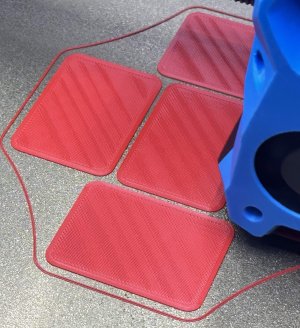- Printer Model
- 300mm Voron 2.4 R2
- Extruder Type
- Clockwork 2
- Cooling Type
- Stealthburner
Hi all,
I'm having an issue with periodic under extrusion and it's driving me nuts. I've attached a representative photo below. This issue occurs both on flats and on walls, with the under extruded parts causing structural failures in walls.
This is Polymaker ASA, printed at 250˚C, 260˚C, or 270˚C (with no appreciable difference between temperatures) on a 100˚C bed with a Dragon SF hot-end, ClockWork2 extruder, and 0.4mm nozzle. This happens for all flow rates I've tested, corresponding to 80-250 mm/s velocity at 0.4mm layer width and 0.2mm layer height (~6-18 mm^3/s). I'm printing enclosed with a chamber temperature of 50-60˚C.
In an attempt at resolving this issue I completely disassembled the extruder looking for faults but found none (granted I'm new to the ClockWork2 mechanism). The drive gear is not slipping on the filament or anything like that (although if I push flow rates to ~25mm^3/s it skips very violently!). Mesh between the drive gears appears to be good. The nozzle is clean and the hot end flows freely when I disconnect the ClockWork2 and feed filament by hand. I performed PID tuning on both the bed and hot-end with both managing to hold the target temperature to within ±0.3˚C for the entire print. Looking at the graphs of the PWM duty cycles don't show any systematic issues either.
I'm at a bit of a loss here. Nothing I've tried seems to make any difference. Can anyone help me diagnose this problem?

I'm having an issue with periodic under extrusion and it's driving me nuts. I've attached a representative photo below. This issue occurs both on flats and on walls, with the under extruded parts causing structural failures in walls.
This is Polymaker ASA, printed at 250˚C, 260˚C, or 270˚C (with no appreciable difference between temperatures) on a 100˚C bed with a Dragon SF hot-end, ClockWork2 extruder, and 0.4mm nozzle. This happens for all flow rates I've tested, corresponding to 80-250 mm/s velocity at 0.4mm layer width and 0.2mm layer height (~6-18 mm^3/s). I'm printing enclosed with a chamber temperature of 50-60˚C.
In an attempt at resolving this issue I completely disassembled the extruder looking for faults but found none (granted I'm new to the ClockWork2 mechanism). The drive gear is not slipping on the filament or anything like that (although if I push flow rates to ~25mm^3/s it skips very violently!). Mesh between the drive gears appears to be good. The nozzle is clean and the hot end flows freely when I disconnect the ClockWork2 and feed filament by hand. I performed PID tuning on both the bed and hot-end with both managing to hold the target temperature to within ±0.3˚C for the entire print. Looking at the graphs of the PWM duty cycles don't show any systematic issues either.
I'm at a bit of a loss here. Nothing I've tried seems to make any difference. Can anyone help me diagnose this problem?


